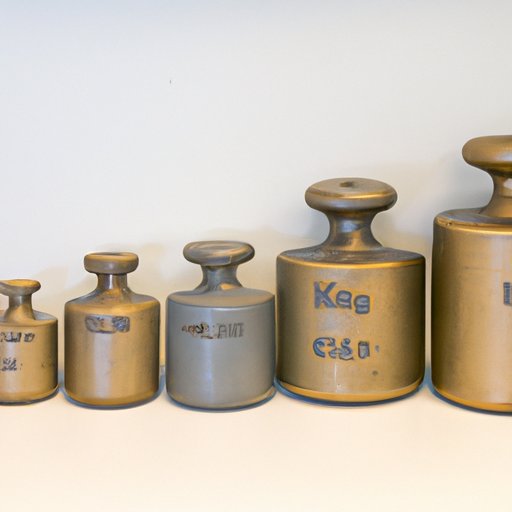
Introduction
Weight measurement is a fundamental aspect of our everyday lives, whether we realize it or not. From cooking recipes to calculating shipping fees, knowing how to measure weight accurately is crucial. In order to do so, it is important to have a solid understanding of the different units of weight measurement and their respective conversions. This article provides a comprehensive guide to understanding weight measurement units and how to utilize them properly.
A Comprehensive Guide to Understanding the Units of Weight
In order to delve into the intricacies of weight measurement, it is important to understand what weight actually is. Weight is the force generated by the gravitational pull on an object by the earth’s surface. This is often confused with mass, which is the amount of matter that an object is composed of. These two terms are often used interchangeably, but they are not the same thing. Mass is typically measured in kilograms, whereas weight is measured in units such as newtons or pounds.
There are several different systems of measurement for weight, but the most commonly used are the metric, imperial, and US customary systems.
The Basics of Weight Measurement
The metric system of measurement is the most widely used system throughout the world. It is based on multiples of ten and is considered to be the most straightforward. The base unit of weight in the metric system is the kilogram (kg). One kilogram is equal to 1000 grams (g). The kilogram is used for measuring the weight of larger items, such as people and animals.
The imperial system is commonly used in the United Kingdom. The base unit of weight in this system is the pound (lb). One pound is equal to 16 ounces (oz). The pound is used for measuring small items, such as food items and household objects.
The US customary system is used in the United States. The base unit of weight in this system is also the pound (lb). However, in this system, one pound is equal to 16 avoirdupois ounces (oz). This system is similar to the imperial system, but there are some slight differences in terms of conversions.
To convert between units of weight, it is important to understand the conversion factors. A conversion chart or calculator may be used to facilitate this process. For example, to convert pounds to kilograms, you would multiply the number of pounds by 0.454. Conversely, to convert kilograms to pounds, you would multiply the number of kilograms by 2.205.
Examples of common objects and their weight in different units include:
- 1 kilogram = 2.2 pounds = 35.3 ounces
- 1 pound = 0.45 kilograms = 16 ounces
- 1 ounce = 28.35 grams = 0.06 pounds = 0.03 kilograms
- 1 gram = 0.04 ounces = 0.002 pounds = 0.001 kilograms
The Science Behind Weight Measurement
Weight measurement has evolved significantly over time. Ancient civilizations used primitive scales made from materials like stone and wood. These scales were not standardized, meaning that different weights were used across different regions.
However, as societies grew and trade expanded, the need for standardized weights and measures became apparent. In the Middle Ages, local governments began using standardized weights for trade, which helped to reduce fraud and promote accurate measurements.
Today, weight measurement is governed by international standards. The International System of Units (SI) is the standard for scientific measurement and is based on the metric system. Its goal is to ensure that measurements are consistent and comparable across different regions and disciplines.
Some fun facts about weight measurement through history include:
- The first known weight measurement system was created by the ancient Egyptians around 5000 years ago. They used a system based on units of 10.
- The Romans used a weight measurement system based on the pound, which is where the term “libra” comes from.
- The metric system was developed during the French Revolution in the late 1700s. It was intended to be a universal system of measurement that would simplify trade and commerce.
Practical Tips for Weighing and Measuring
Accurate weight measurement is essential in a variety of settings, from commercial functions to personal care. Some best practices for using scales and other equipment for accurate measurements include:
- Ensure that the scale is on a flat, stable surface to prevent inaccuracies.
- Calibrate the scale regularly to maintain accuracy.
- Use appropriate units for the item being weighed to minimize rounding errors.
- Take the average of several measurements for more precise results.
Common issues with weight measurement include inaccurate scales, improper calibration, and incorrect use of units. Troubleshooting these issues may require recalibration or replacing equipment.
Understanding Weight and Its Impact on Health
Weight has a significant impact on overall health and well-being. Being overweight or underweight can lead to a variety of health risks and complications, including heart disease, stroke, and diabetes.
It is important to maintain a healthy weight through a balanced diet and regular exercise. Some tips for achieving a healthy weight include:
- Eat a nutrient-dense diet that includes fruits, vegetables, lean protein, and whole grains.
- Limit calorie-dense foods and beverages, such as sugary drinks and processed snacks.
- Incorporate regular exercise into your routine, such as walking or jogging.
- Get adequate sleep to promote overall health and reduce stress.
Conclusion
Weight measurement is a fundamental aspect of daily life in various contexts. Understanding the different units of weight and how to use them properly is essential in ensuring accurate measurements. Whether you are weighing food items in the kitchen or monitoring your weight for health reasons, this comprehensive guide provides a solid knowledge base for effective weight measurement.
Overall, maintaining a healthy weight is crucial for overall health and well-being. By utilizing the tips and information provided in this guide, individuals can take control of their weight measurement and promote a healthier lifestyle.




